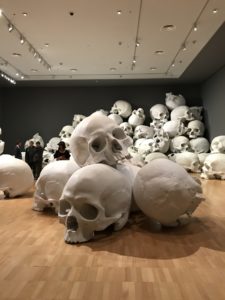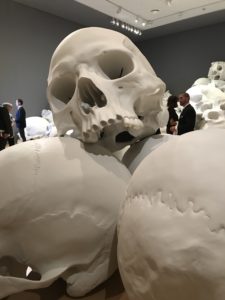Ron Mueck discusses his NGV Triennial installation titled Mass
For those who are travelling to the NGV Triennial at the National Gallery of Victoria (and you won’t be disappointed) one of the most ambitious works to enjoy is Ron Mueck’s largest installation to date, a new piece commissioned by the NGV for its inaugural NGV Triennial.
Titled Mass, the piece is comprised of 100 giant-sized skulls positioned within the 17th and 18th Century halls of the NGV. Its impact is huge.
I interviewed Mueck for The Art Newspaper, but of course the entire interview could hardly be used in an article. So I reproduce it here for those aficionados who love to hear from the horse’s mouth about an artist’s process and thoughts as they make a work.

Mass, Ron Mueck’s largest installation to date, is a key work in the inaugural NGV Triennial at the National Gallery of Victoria in Melbourne.
Here’s the interview:
Elizabeth Fortescue: What are the skulls in Mass made from?
Ron Mueck: The skulls are made of fibreglass and polyester resin.
EF: Were you able to make them yourself in your studio?
RM: The short answer is: I started them in the UK and they were completed in Melbourne. The long winded version is: I started the project in my studio in the UK where I sculpted the original skull in water based clay and made a couple of silicone moulds that would ultimately be used to cast multiple copies.
Initially I cast five skulls from these moulds to ensure they worked and to determine the best process and materials.
Because the original clay model gets destroyed in the moulding process, I cast out a ‘master skull’ in resin to make additional moulds from.
This master skull and the two moulds were shipped to Australia.
While we were making the moulds, the NGV were looking into setting up a workshop in Melbourne where the skulls could be produced. This was clearly going to be a better solution than shipping 100 large scale sculptures halfway across the world.
We looked at a few different possible set ups and ultimately decided it would be best to work with an established, specialist fibreglass company with all the necessary facilities in place rather than setting up a workshop from scratch. The NGV found a Melbourne-based company (King’s Fibreglass) who fitted the bill.
I came out to Australia shortly after the moulds and master skull arrived and spent a couple of weeks at King’s working with the skull crew. The skull moulds were quite different to those they usually worked with and we worked through the idiosyncrasies and complications and cast out the first couple of skulls.
Timing was always going to be a major consideration and it became clear that we would need a separate crew dedicated to cleaning up and finishing the casts as they came out of the fibreglass workshop. The NGV put together a group of technicians from their pool of art handlers. Initially there were two but this team expanded to about eight people.
With two moulds it was possible to launch into the casting process but moulds deteriorate as they are used and we knew that we would need additional moulds as the work proceeded. I spent three weeks with another company, Idea Productions, making a third mould and they subsequently made a further two giving us a total of five moulds which meant that at one point there were five, occasionally six skulls being produced a week.
With the production process established I went back to the UK to clean up the studio there and start preliminaries for the next work. Progress reports and images sent to me in the UK kept me up to date. We discussed problems that arose and figured out solutions as necessary but on the whole, due to the talent and dedication of everyone involved, it all ran pretty smoothly.
I arrived back in Oz a couple of weeks before the end of production to join the NGV finishing crew for the final burst of activity.
The Australian end of the project took about eight months.
An extraordinary amount of work achieved to a superb standard by a fantastic team.
EF: Did you use any particular skull as your model for the work?
RM: I made a point of not using a specific skull type. The sex, age and ethnicity of individual skulls is visually apparent and I tried to come up with a somewhat ‘universal skull’ so that the interpretation of the work would not be confined to a particular narrative.
EF: What is the scale of the skulls compared to an actual skull?
RM: I haven’t figured out the exact ratio.
The skulls are about a metre tall sitting on the floor.
I generally just go for what feels right to me when I’m making the work.
I sketched out a couple of different sizes on large sheets of paper, chose the one that felt a good size to stand beside, and then made a three dimensional cardboard mock-up of that size so I could get a sense of it in the round.
EF: Is this your largest work to date?
RM: Yes, although it is a work of variable dimensions. It will be reconfigured each time it is displayed. I imagine the size and atmosphere of each venue will influence the arrangement.
EF: The depiction of the human skull as a memento mori dates back hundreds of years. Can Mass be viewed as a giant memento mori?
RM: Certainly. Memento mori and the vanitas tradition in art remind us of the brevity of life.
EF: Did you have any particular human or world events in mind when you made it? I was reminded of the terrible piles of skulls left behind by Pol Pot’s regime, for example.
RM: Over the years I have collected a number skull images from various sources…from Paul Cézanne’s Pyramid of Skulls to Cambodian killing fields or the catacombs of Paris. These have all played a part in the development of Mass.
by Elizabeth Fortescue, posted on December 27, 2017
Sydney, Australia
| Print article | This entry was posted by Elizabeth Fortescue on December 27, 2017 at 12:01 pm, and is filed under News. Follow any responses to this post through RSS 2.0. You can leave a response or trackback from your own site. |

